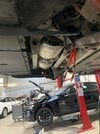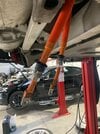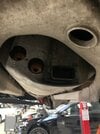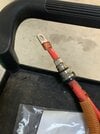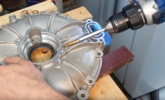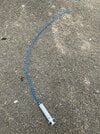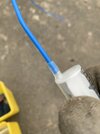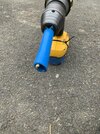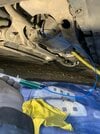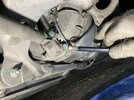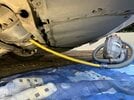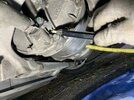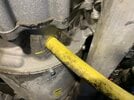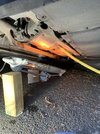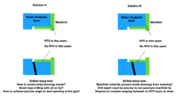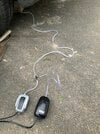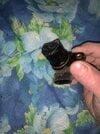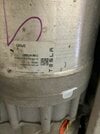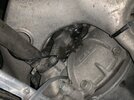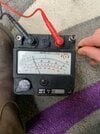Hello everyone,
Here is my problem:
26/12: my Tesla model S gave me error messages: GTW_w018 and w157: reduced electrical power; GTW_w174 and w177: provide battery replacement based on voltage (12v); regenerative braking off; GTW_w017 reduced power.
But she continued to drive.
Then on 28/12: it drives, I stop to buy bread and when I want to restart, then it no longer starts: DI_w127: parked carefully, BMS_f027 and GTW_w176: impossible to start.
It is no longer guaranteed, as it was registered in 2014.
Call from the tow truck, direction the Tesla garage.
The garage told me that it had disconnected the + and - of the motor (power side) and discovered moisture there. This is due to the seals on the DC cables which are HS.
By the way, the courtesy vehicle at Tesla is free during the warranty period, then it's 130€ per day. I should have taken advantage of it more often when it was guaranteed.
To change the seals, the cables must be replaced because they are crimped at the factory. The seals are not replaceable because they are blocked between the crimped terminals. (1,000€)
In addition, the humidity having entered the engine (rain), the engine block must be completely replaced. Standard exchange. There is a current leak, visible on the megger (mega ohm meter). Motor insulation fault which causes all the faults mentioned above to appear. (6 500€)
So an estimate of €7,500.
I ask them: is it possible to try to let the engine dry
Answer: yes, we can try but if it works, I will have you sign a liability waiver in the event of electrocution because there has been water observed in the motor. I say ok.
The estimate is updated to 1500€ for the cables, I validate.
A week later, he calls me: still the same, current leakage fault. In addition, the estimate and redone: €8,000
I ask where the extra €500 comes from: answer: we have to look. Do you still have the quote for €7,500? we no longer have the initial (dematerialized) quote.
No luck, me either because I did not print it.
I ask to see the car in the workshop. I note that there is nothing openable on the motor to dry it, apart from 2 holes DN 20 (the penetration of the + and - cable). There is an inspection hatch (~10cm by 5cm) in the center of the engine block but it has not been opened… (it does not help drying in my opinion)
I ask if a second-hand engine is possible: answer: it is already a reconditioned engine in the estimate.
Surprise on my part.
But hey, the quote is in English (Tesla Lille), it may have been written but I'm not good at English.
So, I ask to have my engine reconditioned. Answer: it is an operation carried out in Amsterdam but only for Tesla, internally. Not for customers. At the garage, we only do standard exchanges of the entire engine block.
Info: A reconditioned engine is guaranteed for 4 years.
I indicate that: My engine block was replaced 2 years ago, free of charge because the car was still under the 8-year warranty. Answer: He tells me that it was also a reconditioned engine but that it does not benefit from the 4-year warranty because it is only the remaining time of the car under warranty that is taken into account.
This is where I am.
I'm thinking of bringing the vehicle back to my house to actually try to dry it out.
I hope to be able to send a flow of warm air into one of the DN20 holes + put a heating blanket over the entire engine block for 1 week.
I also need to find a megohmmeter to be able to test before-during and -after.
When do you think ?
Here is my problem:
26/12: my Tesla model S gave me error messages: GTW_w018 and w157: reduced electrical power; GTW_w174 and w177: provide battery replacement based on voltage (12v); regenerative braking off; GTW_w017 reduced power.
But she continued to drive.
Then on 28/12: it drives, I stop to buy bread and when I want to restart, then it no longer starts: DI_w127: parked carefully, BMS_f027 and GTW_w176: impossible to start.
It is no longer guaranteed, as it was registered in 2014.
Call from the tow truck, direction the Tesla garage.
The garage told me that it had disconnected the + and - of the motor (power side) and discovered moisture there. This is due to the seals on the DC cables which are HS.
By the way, the courtesy vehicle at Tesla is free during the warranty period, then it's 130€ per day. I should have taken advantage of it more often when it was guaranteed.
To change the seals, the cables must be replaced because they are crimped at the factory. The seals are not replaceable because they are blocked between the crimped terminals. (1,000€)
In addition, the humidity having entered the engine (rain), the engine block must be completely replaced. Standard exchange. There is a current leak, visible on the megger (mega ohm meter). Motor insulation fault which causes all the faults mentioned above to appear. (6 500€)
So an estimate of €7,500.
I ask them: is it possible to try to let the engine dry
Answer: yes, we can try but if it works, I will have you sign a liability waiver in the event of electrocution because there has been water observed in the motor. I say ok.
The estimate is updated to 1500€ for the cables, I validate.
A week later, he calls me: still the same, current leakage fault. In addition, the estimate and redone: €8,000
I ask where the extra €500 comes from: answer: we have to look. Do you still have the quote for €7,500? we no longer have the initial (dematerialized) quote.
No luck, me either because I did not print it.
I ask to see the car in the workshop. I note that there is nothing openable on the motor to dry it, apart from 2 holes DN 20 (the penetration of the + and - cable). There is an inspection hatch (~10cm by 5cm) in the center of the engine block but it has not been opened… (it does not help drying in my opinion)
I ask if a second-hand engine is possible: answer: it is already a reconditioned engine in the estimate.
Surprise on my part.
But hey, the quote is in English (Tesla Lille), it may have been written but I'm not good at English.
So, I ask to have my engine reconditioned. Answer: it is an operation carried out in Amsterdam but only for Tesla, internally. Not for customers. At the garage, we only do standard exchanges of the entire engine block.
Info: A reconditioned engine is guaranteed for 4 years.
I indicate that: My engine block was replaced 2 years ago, free of charge because the car was still under the 8-year warranty. Answer: He tells me that it was also a reconditioned engine but that it does not benefit from the 4-year warranty because it is only the remaining time of the car under warranty that is taken into account.
This is where I am.
I'm thinking of bringing the vehicle back to my house to actually try to dry it out.
I hope to be able to send a flow of warm air into one of the DN20 holes + put a heating blanket over the entire engine block for 1 week.
I also need to find a megohmmeter to be able to test before-during and -after.
When do you think ?



